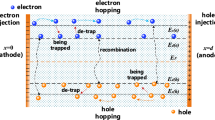Abstract
Polyimide (PI) films are wildly used in the field of electrical equipment and electronic devices due to their excellent thermal, electrical, and mechanical properties. The various mechanisms of sample thickness on the electrical breakdown of polyimide have been proposed. The purpose of this study is to apply the state of macromolecular aggregation to analyze the breakdown strength of PI film with different thickness. In this paper, the direct current (dc) electrical breakdown properties of PI films as a function of thickness were investigated employing water absorption, mechanical properties, thermal properties, and thermally stimulated depolarization current (TSDC). These experimental results exhibit a good coincidence with the breakdown measurement. On the condition of the structure of the polymeric molecules to the same case, the congregating state of the polymer might be the fundamental reason causing the dc electrical breakdown field of PI film with different thickness.





Similar content being viewed by others
References
Govindaraj B, Sarojadevi M (2018) Polym Adv Technol 29:1718
Gu J, Lv Z, Wu Y, Guo Y, Tian L, Qiu H, Li W, Zhang Q (2017) Compos A Appl Sci Manuf 94:209
Zhi X, Jiang G, Zhang Y, Jia Y, Wu L, An Y, Liu J, Liu Y (2022) J Appl Polym Sci 139:51544
Ogbonna VE, Popoola A, Popoola OM, Adeosun SO (2022) Polym Bull 79:663
Hu P, Shen Y, Guan Y, Zhang X, Lin Y, Zhang Q, Nan W (2014) Adv Func Mater 24:3172
Liu XJ, Zheng MS, Chen G, Dang ZM, Zha JW (2021) Energy Environ Sci 15:56
Tanaka T, Montanari GC, Mulhaupt R (2004) IEEE Trans Dielectr Electr Insul 11:763
Lee JI, Kim M, Park KC, Lee CY, Park YD (2022) Mater Chem Phys 278:125661
Fu M, Chen G, Dissado LA, Fothergill JC (2007) IEEE Trans Dielectr Electr Insul 14:53
Tanaka K, Okano M, Kita H, Okamoto KI, Nishi S (1994) Polym J 26:1186
Abdel-Salam M (2007) IEEE Trans Ind Appl 21:35
Klein N (1978) Thin Solid Films 50:223
Diaham S, Zelmat S, Locatelli ML, Dinculescu S (2010) IEEE Trans Dielectr Electr Insul 17:18
Paskaleva A, Atanassova E, Lemberger M, Bauer AJ (2006) Springer. Netherlands 220:422
Forlani F, Minnaja N (1969) J Vac Sci Technol 6:518
Chen G, Zhao J, Li S, Zhong L (2012) Appl Phys Lett 100:2135
Neusel C, Jelitto H, Schmidt D, Janssen R, Felten F (2015) J Eur Ceram Soc 35:113
Min D, Li Y, Yan C, **e D, Li S, Wu Q (2018) Polymers 10:3390
Feng QK, Liu DF, Zhang YX, Pei JY, Zhong SL, Hu HY, Wang XJ, Dang ZM (2022) Nano Energy 99:107410
Diaham S, Zelmat S, Locatelli ML, Dinculescu S, Decup M, Lebey T (2010) IEEE Trans Dielectr Electr Insul 17:18
Nakashima Y, Zhou Y, Tanabe K, Arima S, Hirao K, Ohji T, Murayama N, Fukushima M (2022) J Am Ceram Soc 106:1139
Nakashima Y, Hyuga H, Hirao K, Zhou Y, Fukushima M, Murayama N (2021) J Ceram Soc Jpn 129:761
Stark S (2022) J Eur Ceram Soc 42:462
Zhao L, Liu CL (2020) Nanomaterials 10:2473
Zakrevskii VA, Pakhotin VA, Sudar NT (2014) J Appl Phys 115:234101
Zhang CY, Shi WC, Wang Q, Hiziroglu HR (2021) Polymers 13:2956
Liufu D, Wang X, Tu D, Kao K (1998) J Appl Phys 83:2209
Wang HY, Xu YZ, Yu XH, **ng RB, Liu JG, Han YC (2014) Polymers 5:1272
Min DM, Cui HZ, Wang WW, Wu QZ, **ng ZL, Li ST (2019) Compos Sci Technol 184:107873
Mazzanti G, Montanari GC, Alison JM (2003) IEEE Trans Dielectr Electr Insul 10:187
Akram S, Yang Y, Zhong X (2018) IEEE Trans Dielectr Electr Insul 25:1461
Bisquert J, Halpern V (2001) J Phys D Appl Phys 34:22
Chen DN (1987) J Phys 7:838
Lei QQ (1990) Huazhong University of Science and Technology Press 247 (in Chinese)
Takahashi F, Ito K, Morikawa J, Hashimoto T, Hatta I (2004) Jpn J Appl Phys Part 1 43:7200
Yin Y, Tu DM, Li M, Li ZH (2000) Proceedings of the CSEE 20:4
Funding
This work is supported by the State Key Laboratory of Alternate Electrical Power System with Renewable Energy Sources (Grant No. LAPS21022) and the fund of **nbang Electronic Co. Ltd (Grant No. 20213702030785).
Author information
Authors and Affiliations
Corresponding author
Ethics declarations
Consent for publication
The article is original, has been written by the stated authors who are all aware of its content and approve its submission, and has not been published previously; it is not under consideration for publication elsewhere.
Conflict of interest
No conflict of interest exists.
Additional information
Publisher's Note
Springer Nature remains neutral with regard to jurisdictional claims in published maps and institutional affiliations.
Rights and permissions
Springer Nature or its licensor (e.g. a society or other partner) holds exclusive rights to this article under a publishing agreement with the author(s) or other rightsholder(s); author self-archiving of the accepted manuscript version of this article is solely governed by the terms of such publishing agreement and applicable law.
About this article
Cite this article
Ba, Z., Liu, H., Li, C. et al. Study on direct current electrical breakdown properties of polyimide films with different thickness. Colloid Polym Sci 301, 313–318 (2023). https://doi.org/10.1007/s00396-023-05060-x
Received:
Revised:
Accepted:
Published:
Issue Date:
DOI: https://doi.org/10.1007/s00396-023-05060-x




